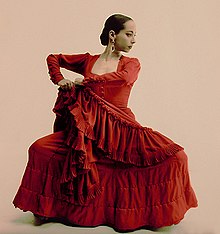Flamenco dancing
| Flamenco | |
|---|---|

Flamenco dancer with traditional dress
|
|
| Stylistic origins | |
| Cultural origins |
|
| Typical instruments | |
| Subgenres | |
| New Flamenco () | |
| Fusion genres | |
| Flamenco chill (with downtempo) | |
| Other topics | |
Flamenco (Spanish pronunciation: [flaˈmeŋko]), in its strictest sense, is a professionalized art-form based on the various folkloric music traditions of Southern Spain in autonomous community of Andalusia, Extremadura and Murcia. In a wider sense, it refers to these musical traditions and more modern musical styles which have themselves been deeply influenced by and become blurred with the development of flamenco over the past two centuries. It includes cante (singing), toque (guitar playing), baile (dance), jaleo (vocalizations), palmas (handclapping) and pitos (finger snapping).
The oldest record of flamenco dates to 1774 in the book Las Cartas Marruecas by José Cadalso. The genre originated in the music and dance styles of Andalusia, of much older origin. Flamenco has been influenced by and become associated with the Romani people in Spain, however, unlike Romani music in Eastern Europe, its origin and style is uniquely Andalusian.
In recent years, flamenco has become popular all over the world and is taught in many non-Hispanic countries, especially the United States and Japan. In Japan, there are more flamenco academies than there are in Spain. On November 16, 2010, UNESCO declared flamenco one of the Masterpieces of the Oral and Intangible Heritage of Humanity.
There are many suggestions for the origin of the word flamenco as a musical term (summarized below) but no solid evidence for any of them. The word was not recorded as a musical and dance term until the late 18th century.
The Spanish word could have been a derivative of "fire" or "flame". The word flamenco may have come to be used for fiery behaviour, which could have come to be applied to the Gitano players and performers.
...
Wikipedia
